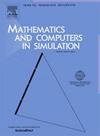Learning time-varying parameters of stiff dynamical systems using physics-informed transfer neural network
IF 4.4
2区 数学
Q1 COMPUTER SCIENCE, INTERDISCIPLINARY APPLICATIONS
引用次数: 0
Abstract
Learning the time-varying parameters of stiff dynamical systems is challenging due to their sensitivity to initial conditions and rapid dynamics. We introduce a framework based on Physics-Informed Transfer Learning Neural Networks to learn the time-varying parameters of stiff dynamic systems effectively. The framework leverages prior knowledge embedded in pre-trained models by transferring the learned model parameters to a sequential neural network architecture. This framework admits the dataset, transfers parameters from the pre-trained network, and outputs the solution to the system. Then, the system’s solution is used as input to learn the time-varying parameters. We evaluate this approach on four benchmark problems: the Robertson problem, a damped oscillator, and the High Irradiance Response problem from biochemical kinetics. Results demonstrate that the approach can accurately learn time-varying parameters and capture complex dynamics, providing a robust tool for stiff differential equations in scientific computing.
利用物理信息传递神经网络学习刚性动力系统时变参数
由于刚性动力系统对初始条件的敏感性和动态的快速性,对其时变参数的学习具有挑战性。为了有效地学习刚性动态系统的时变参数,提出了一种基于物理信息迁移学习神经网络的框架。该框架利用嵌入在预训练模型中的先验知识,将学习到的模型参数转移到顺序神经网络架构中。该框架允许数据集,从预训练的网络中传输参数,并向系统输出解决方案。然后,将系统解作为学习时变参数的输入。我们在四个基准问题上评估了这种方法:罗伯逊问题,阻尼振荡器和生化动力学的高辐照度响应问题。结果表明,该方法可以准确地学习时变参数并捕获复杂动力学,为科学计算中的刚性微分方程提供了强大的工具。
本文章由计算机程序翻译,如有差异,请以英文原文为准。
求助全文
约1分钟内获得全文
求助全文
来源期刊

Mathematics and Computers in Simulation
数学-计算机:跨学科应用
CiteScore
8.90
自引率
4.30%
发文量
335
审稿时长
54 days
期刊介绍:
The aim of the journal is to provide an international forum for the dissemination of up-to-date information in the fields of the mathematics and computers, in particular (but not exclusively) as they apply to the dynamics of systems, their simulation and scientific computation in general. Published material ranges from short, concise research papers to more general tutorial articles.
Mathematics and Computers in Simulation, published monthly, is the official organ of IMACS, the International Association for Mathematics and Computers in Simulation (Formerly AICA). This Association, founded in 1955 and legally incorporated in 1956 is a member of FIACC (the Five International Associations Coordinating Committee), together with IFIP, IFAV, IFORS and IMEKO.
Topics covered by the journal include mathematical tools in:
•The foundations of systems modelling
•Numerical analysis and the development of algorithms for simulation
They also include considerations about computer hardware for simulation and about special software and compilers.
The journal also publishes articles concerned with specific applications of modelling and simulation in science and engineering, with relevant applied mathematics, the general philosophy of systems simulation, and their impact on disciplinary and interdisciplinary research.
The journal includes a Book Review section -- and a "News on IMACS" section that contains a Calendar of future Conferences/Events and other information about the Association.
 求助内容:
求助内容: 应助结果提醒方式:
应助结果提醒方式:


